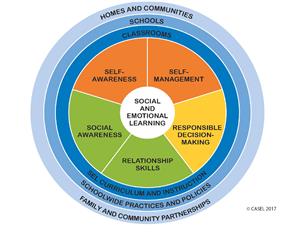Social Emotional Learning
Social and emotional learning (SEL) is the process through which children and adults acquire and effectively apply the knowledge, attitudes, and skills necessary to understand and manage emotions, set and achieve positive goals, feel and show empathy for others, establish and maintain positive relationships, and make responsible decisions.
Related to the image below, the short-term goals of SEL programs are to: (1) promote students’ self-awareness, self-management, social-awareness, relationship, and responsible decision-making skills; and (2) improve student attitudes and beliefs about self, others, and school. These, in turn, provide a foundation for better adjustment and academic performance as reflected in more positive social behaviors and peer relationships, fewer conduct problems, less emotional distress, and improved grades and test sco

The promotion of students’ social and emotional learning. Educators, parents, and policymakers who recognize that the core SEL competencies are necessary for effective life functioning also know these skills can be taught. Extensive research demonstrates that school based SEL programs can promote and enhance students’ connection to the school, positive behavior, and academic achievement (Durlak et al., 2011). Classroom teachers can help students develop social and emotional competencies by directly teaching these skills, by using engaging curriculum materials, and by implementing specific instructional and classroom-management practices.
Some SEL programs teach social and emotional skills directly. Occasionally programs address topics such as substance abuse prevention, violence prevention, health promotion, and character education. Other SEL approaches have specific curricular and instructional components that foster safe, caring, engaging, and participatory learning environments that build student attachment to school, motivation to learn, and academic achievement.(Zins et al., 2004) Recent research has established that the quality of teacher-student interactions and the instructional practices that take place within the classroom are two important predictors of student academic performance and social adjustment (Hamre & Pianta, 2007; Mashburn & Pianta, 2006). Teacher-focused SEL programs train teachers to be more emotionally supportive of their students or to use positive discipline practices to respond to students’ needs. These strategies also enhance student skill development.
As students learn social and emotional skills, It is important that they have opportunities to practice and apply the skills in actual situations and be recognized for using these skills across a variety of settings (Bond & Hauf, 2004; Hawkins et al., 2004; Nation et al., 2003; Weare & Nind, 2011). Given the importance of practice for skill mastery and the influence of adults and peers outside of the school, it is also important to coordinate classroom instruction in social and emotional development with school, family, and community activities (Albright & Weissberg, 2009; Nation et al., 2003; Weare & Nind, 2011). Genuine school-family partnerships involve the promotion of two-way communication between teachers and families and the participation of family members in students’ education both at home and in school. This ensures consistency in the messages students receive and the practices they experience across multiple settings.
The success of evidence-based SEL programs and school-wide programming depends on high-quality implementation. Just selecting a strong program is not enough. Implementation and support for the program are critically important. When districts and schools support high-quality program implementation, program impact is strengthened (Durlak et al., 2011). This is why CASEL advocates the use of evidence-based SEL programs within the context of “school-wide” and “district-wide” approaches (Devaney et al., 2006; CASEL, 2013). Poor program implementation can undermine a program’s success and the extent to which it has an impact on student outcomes (Greenberg, Domitrovich, Graczyk, & Zins, 2005; Durlak & Dupree, 2008; Durlak et al., 2011; Elias, 2006). School-wide factors such as discipline policies, structures, and procedures influence children’s development directly (Bear, 2010) and influence the implementation process of evidence-based programs.
Given these factors, it is important for school administrators to support the effective implementation of SEL programs and to model the SEL language and practices established in the classroom. Administrators also need to endorse the use of SEL practices throughout the school building and provide the necessary professional development (Elias, O’Brien, & Weissberg, 2006; Kam, Greenberg, & Walls, 2003). Regardless of the approach, many SEL programs incorporate school-wide practices that are designed to promote more positive and supportive relationships among teachers, students, and families and/or practices that facilitate integration and support to extend the impact of social and emotional learning programs beyond the classroom.
Social and emotional learning can serve as an organizing principle for coordinating all of a school’s academic, youth development, and prevention activities (Shriver & Weissberg, 1996). It provides a common language and coordinating framework for communicating not just about SEL but about a wide range of programs and teaching approaches that schools normally provide (Elias et al., 1997; Devaney et al., 2006). When systemic social, emotional, and academic learning becomes the overarching framework for a district or school, the result is an organization whose integrated programming activities are greater than the sum of its parts.
Cited from click here to visit site
